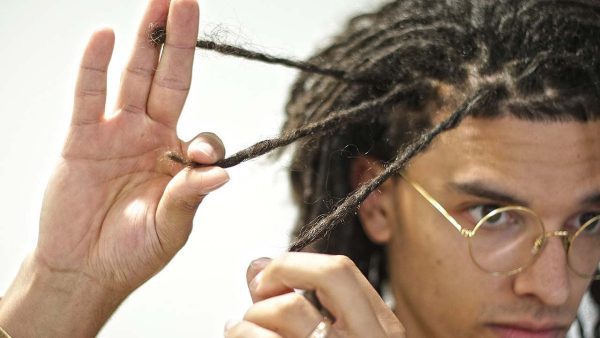
Many people looking for a distinctive and expressive look are choosing the increasingly popular and stylish dreadlock haircut, which has roots in many different cultures across the globe. Whether you’re drawn to the cultural importance, the low-maintenance lifestyle, or the aesthetic appeal, one frequently asked question is, “How much hair do you need for dreadlocks?”. This article will guide you on how to attain the ideal dreadlock length by examining the variables that affect the formation of dreadlocks.
How Much Hair Do You Need for Dreadlocks
The quantity of hair required for dreadlocks differs among individuals due to the aforementioned factors. Generally, however, at least 6 inches (15 cm) of hair is required to initiate the dreadlocking procedure. Bear in mind that dreadlocks will appear lengthier and more mature with the use of longer hair.
Those with shorter tresses must exercise patience. It is possible to maintain and modify dreadlocks as they progress in length. Additionally, length can be achieved with the use of hair extensions.
Factors To Consider When Embarking on Your Dreadlocks Journey
Hair Type
The simplicity and velocity with which one can construct dreadlocks are substantially influenced by the type of hair an individual possesses. In general, those with coarse, curly, or kinky hair encounter less difficulty in establishing and sustaining dreadlocks than those with straight hair. The extent to which your hair can maintain the coils required for dreadlocks can be influenced by its texture.
Hair Length
Although it is possible to begin dreadlocking with shorter hair, the process is typically more time-consuming and results in more mature and substantial dreads. Extended hair supplies an ample amount of material for the development of dreads and facilitates an expanded array of grooming alternatives.
Density
The density or thickness of your hair can influence the aspect of your dreadlocks as a whole. Individuals whose hair is thinner may have dreadlocks that appear lighter in weight, whereas those whose hair is denser may perceive their dreadlocks as appearing fuller. The quantity of hair required is determined by the intended number of dreadlocks and the thickness of each dread.
Maintenance and Styling
In addition to influencing the quantity of hair required, the maintenance regimen and styling techniques employed on dreadlocks can also have an impact on this aspect. Consistent maintenance practices, including palm-rolling and separating, can effectively inhibit the merging of dreads. Furthermore, the quantity of hair necessary may be influenced by the technique selected to erect locks, including backcombing, twisting, and tearing, or freeform.
Additional Tips on Growing Healthy Dreadlocks
a. Maintain Clean Hair: Despite common perception, clean hair is necessary to achieve healthy dreadlocks. It is important to keep your hair strands clean, so it is recommended to regularly cleanse them with residue-free shampoos.
b. Don’t Use Wax: While some products can help with the locking process, it’s generally advised to avoid waxes. They can gather dust and hinder the maturation of dreadlocks.
c. Enjoy the Ride: Embrace the process of adorning your hair with distinctive and articulate dreadlocks. To customize your appearance, try out various designs and accessories.
FAQs About How Much Hair You Need for Dreadlocks
If you’re thinking about getting dreadlocks, you probably have some questions about the amount of hair required and the factors that affect the process. These frequently asked questions (FAQs) that will help you on your path to achieving breathtaking dreadlocks:
1. How long does my hair need to be before starting dreadlocks?
Ideally, your hair should be at least 6 inches (15 cm) long to start the dreadlocking process. Longer hair provides more material for the dreads to take shape, resulting in a more robust and visually appealing outcome.
2. Can I get dreadlocks with short hair?
While it’s possible to start dreads with shorter hair, it can be more challenging. Short hair may not have enough length for stable locks, and the process may take longer to achieve the desired look.
3. Does hair type matter when getting dreadlocks?
Yes, hair type plays a crucial role. Coarser and curlier hair tend to lock more easily than straight or fine hair. However, individuals with various hair textures can achieve locks with the right techniques and patience.
4. What methods can I use to start dreadlocks?
There are several methods to start dreads, including Twist and Rip, Backcombing, and Freeform. The choice of method depends on personal preference, hair type, and the desired outcome. Consulting with a professional stylist can help you choose the best method for your hair.
5. How long does it take for dreadlocks to form?
The time it takes for dreadlocks to form varies based on factors such as hair type, chosen method, and maintenance. Generally, the process can take several months to a year or more. Regular maintenance is essential to encourage the locking process and prevent unwanted loops or gaps.
6. Is it necessary to have dirty hair for dreadlocks to form better?
No, clean hair is essential for successful dreadlocks. Clean hair locks better, and regular washing with residue-free shampoos is recommended. Dirty hair can hinder the dreadlocking process and may lead to hygiene issues.
7. Should I use wax for dreadlocks?
It’s generally advised to avoid waxes, as they can attract dust and hinder the maturation of dreadlocks. While some products are designed to aid in the locking process, it’s essential to choose those that don’t leave residues.
8. Can I have a mix of dreadlock methods on my head?
Yes, it’s possible to have a mix of dreadlock methods on your head. Some people prefer a combination of techniques to achieve a unique and personalized look. Consult with a professional stylist to discuss the best approach for your hair.
9. How often do I need to maintain my dreadlocks?
Regular maintenance is crucial for dreadlocks. New dreads may require attention every few weeks to encourage the locking process and maintain a neat appearance. As the dreads mature, maintenance can be less frequent.
10. Can I undo or remove dreadlocks if I change my mind?
While it’s possible to remove dreadlocks, the process can be time-consuming and may require cutting the hair. It’s essential to consider the commitment involved before getting dreadlocks.
Wrap Up
In summary, the quantity of hair required to create dreadlocks is contingent upon a multitude of elements, encompassing hair length, type, and the selected formation technique. Although specific hair textures may possess an advantage in the locking process, anyone with the proper maintenance and styling skills can attain aesthetically pleasing locks. Regardless of whether you choose a structured method such as twist and tear or a freeform approach, remember that the process of transforming your hair into a distinctive and culturally rich style requires patience and an appreciation for the unique journey it entails.

Leave a Reply